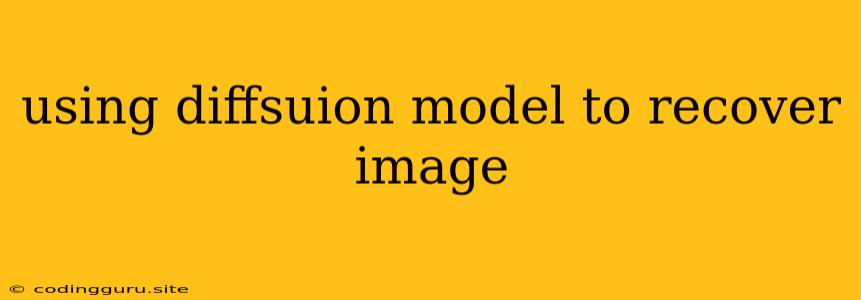Using Diffusion Models to Recover Images: A Deep Dive into Image Restoration
The realm of image processing has witnessed remarkable advancements in recent years, with diffusion models emerging as a powerful tool for image recovery. These models excel at reconstructing images from various forms of degradation, such as noise, blur, or missing information. But how do they work, and what makes them so effective? Let's delve into the intricacies of diffusion models and explore their application in image recovery.
Understanding the Basics of Diffusion Models
At their core, diffusion models operate on the principle of gradually adding noise to an image until it becomes unrecognizable. This process simulates the gradual degradation of an image over time. The key lies in learning to reverse this process, allowing the model to "undo" the added noise and reconstruct the original image.
Imagine a photograph being exposed to increasingly severe weather conditions: rain, dust, scratches, and more. This degradation process, much like adding noise, slowly obscures the original details. Diffusion models essentially learn to "reverse the storm," gradually removing the noise and revealing the underlying image.
How Do Diffusion Models Recover Images?
The magic lies in the model's ability to learn the forward diffusion process—adding noise—and then reverse it. This learning is achieved through extensive training on vast datasets of images. The model analyzes countless examples of clean and noisy images, understanding the patterns and relationships between the two states.
During recovery, the model receives a degraded image. It then iteratively applies a series of "denoising steps," gradually reducing the noise and restoring the image to its original quality. Each step leverages the model's learned knowledge about the diffusion process to guide the reconstruction.
Applications of Diffusion Models in Image Recovery
The versatility of diffusion models makes them a powerful tool for various image recovery tasks, including:
- Noise Removal: Diffusion models excel at eliminating random noise, like "grain" in photographs or "salt and pepper" noise introduced during image transmission.
- Blur Restoration: Whether caused by camera shake or motion blur, diffusion models can effectively sharpen and restore images, recovering lost details.
- Image Inpainting: When parts of an image are missing or damaged, diffusion models can fill in the gaps intelligently, creating seamless and visually realistic completions.
- Super-Resolution: Diffusion models can upscale low-resolution images, generating high-resolution versions with enhanced details and clarity.
Advantages of Diffusion Models for Image Recovery
Compared to traditional image restoration techniques, diffusion models offer significant advantages:
- Improved Accuracy: They achieve higher accuracy in recovering images, particularly in scenarios with complex degradation patterns.
- Generative Capability: Diffusion models can not only restore images but also generate realistic and diverse images based on input data, opening up exciting possibilities for image synthesis.
- Robustness: They exhibit strong robustness to various types of noise and degradation, making them highly adaptable to real-world scenarios.
Conclusion
Diffusion models represent a significant advancement in image recovery technology. Their ability to learn the intricate process of image degradation and reverse it with impressive accuracy makes them invaluable for tasks like noise removal, blur restoration, and image inpainting. As research and development continue, we can expect even more sophisticated applications and refinements, pushing the boundaries of image restoration further.
